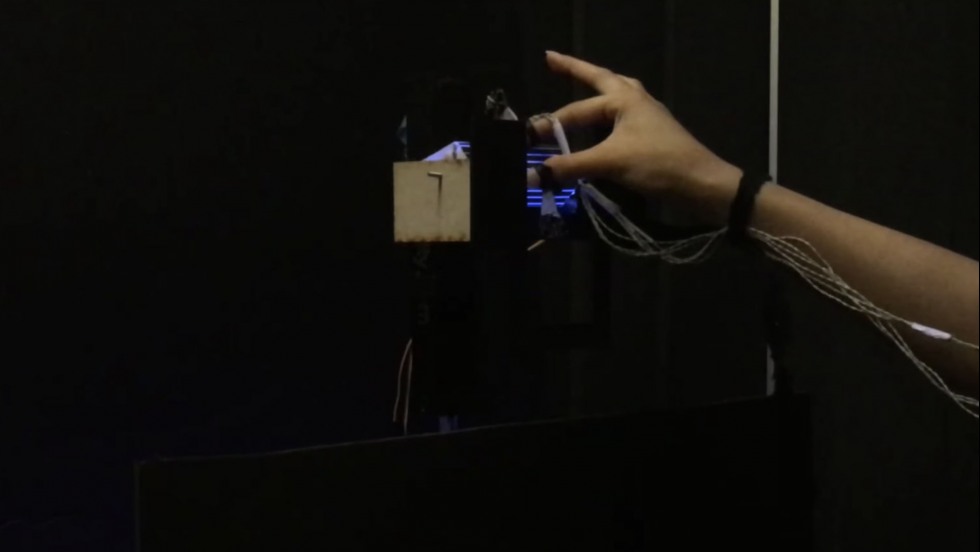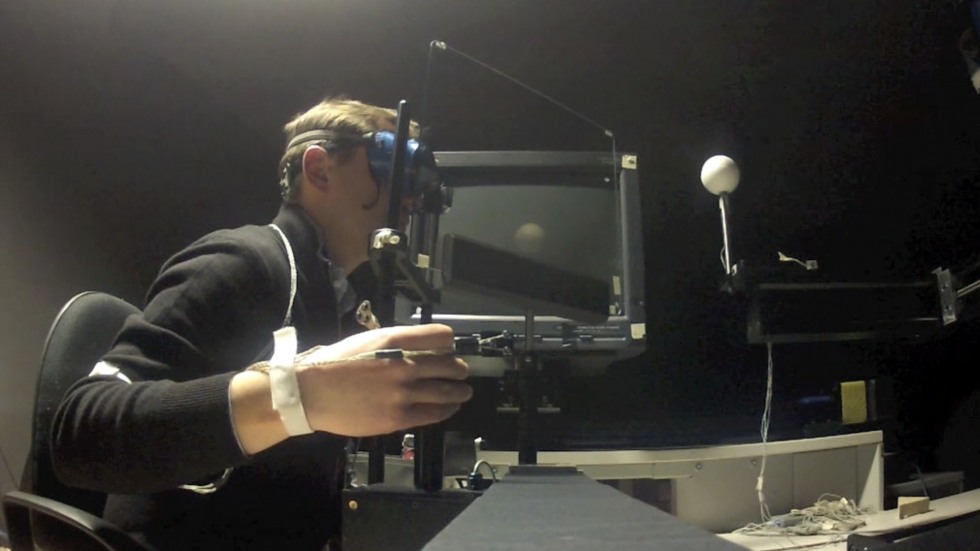In the lab or on the web, research-based courses teach students to think like scientists
This spring, a series of course-based research experiences — or CUREs — explored what it means to conduct scientific research in a virtual world.

An experimenter adjusts the virtual reality machine in Fulvio Domini's lab. Domini has invited students in his CURE course to run their virtual reality experiments on the machine when the lab reopens.

An experimenter uses the virtual reality machine in Fulvio Domini's lab.
PROVIDENCE, R.I. [Brown University] — When Fulvio Domini’s undergraduate course on the human vision system began this spring, it centered around a state-of-the-art new virtual reality machine and a classroom of students eager to design and execute original experiments using the technology.
But just as the students in Experimental Analysis of Vision for Action and Vision in Perception were planning the experiments they would conduct on Domini’s newly-purchased virtual reality machine, COVID-19 hit Rhode Island — forcing nearly all Brown students to evacuate campus in just over a week, with laboratory work suspended soon after.
“It couldn’t have been a worse-case scenario,” said Domini, a professor of cognitive, linguistic and psychology sciences. “We had all this very cool stuff ready to go, and then this happens.”
Domini did not face this challenge alone. His was one of eight spring courses at Brown designated as CUREs— research-based undergraduate science courses that the University began offering in Spring 2019 with support from a five-year Howard Hughes Medical Institute grant. According to program director Mark Johnson, CURE courses build upon the premise — illustrated in education research — that “the best way to get students really interested in science is to have them do science” by designing and executing original laboratory experiments that address a current scientific question.
While faculty members across campus raced to bring their courses online, CURE professors like Domini met a specific question: How best to remotely teach courses centered upon students creating and conducting original, lab-based scientific research?
“ As a scientist, sometimes your experiments will fail, maybe your results won’t be complete by your deadline, or maybe you will have to collect preliminary data and use that information to apply for external funding.
In these moments, you ask: What are the other things I can do as a scientist when I don’t have experiments before me? ”
The group had just over one week before classes resumed to find answers. They convened virtually and consulted science education specialists at the Sheridan Center for Teaching and Learning who had supported the development of CURE courses since the University’s first call for proposals in 2018.
The result? A range of course revisions — from subtle shifts to radical redesigns — that foregrounded what it means to “do science” in a virtual world.
“It’s really cool that students get to use their hands to do their own experiments,” said Stacey Lawrence, associate director for STEM initiatives at the Sheridan Center and a CURE course advisor. “But what happens when your ability to do those experiments is limited? What else can you shift the focus to? What other disciplinary practices can you emphasize in the course that aren’t necessarily the collection of data?”
For scientists, these questions are not unique to the current remote moment, Lawrence added.
“As a scientist, sometimes your experiments will fail, maybe your results won’t be complete by your deadline, or maybe you will have to collect preliminary data and use that information to apply for external funding. In these moments, you ask: What are the other things I can do as a scientist when I don’t have experiments before me?”
Thinking like a scientist
For most members of the spring CURE faculty cohort, remotely teaching meant helping students develop the deep analytic skills that all scientists depend upon when drafting grants, developing experiments, analyzing results and discussing the impact of their work.
When campus buildings and operations began to shut down, the students in Toni-Marie Achilli’s Antibiotic Drug Discovery course — part of the Tiny Earth Network, a national program that invites students to find novel antibiotic-producing bacteria in their local soil — had discovered antibiotics in some of the samples that they had gathered around campus, but they had not yet begun the experiments that would show whether any of those antibiotics were novel.
In adapting her course to work remotely, Achilli — a lecturer in molecular pharmacology, physiology and biotechnology — designed a new final project that provided students with rigorous data analysis experience, despite the limited data that they had collected on their own samples. To achieve this, she asked teams of students to compare their preliminary data sets to complete data sets that students had gathered during an earlier version of the course that had run through Summer@Brown.
By comparing their incomplete data sets to the fuller data compiled in the earlier course, Achilli’s students were able to hypothesize the likelihood that their soil samples contained novel antibiotics that had not been found the previous summer.
“We shifted our focus to how scientists use data that is already available to inform their hypotheses — how we think critically about the information we already have and propose future experiments based on it,” Achilli said.
For Alexandra Trouilloud, a rising junior studying biology, the changes to the course underscored the role that flexibility plays in scientific research: “The first thing you learn about being a scientist is that not everything will go the way you plan, and you have to be ready to adjust.”
The course’s shift to collaborative analysis during the remote half of the term also reflected the types of skills that successful scientific researchers need, said Daniel Alber, a rising junior studying applied math.
“The long-distance teamwork component has been invaluable,” he said. “Pretty much every researcher in the country needs to work like this right now.”
Alber, who intends to apply to medical school after graduation, also appreciated the class’s new emphasis on predictive analysis: “I think learning to anticipate the shape of the data and results that you’re going to get is an extremely valuable skill. It helps you think of the multiple directions you may take and the possible challenges that may arise when you’re designing an experiment.”
In Domini’s course on the human vision system, the focus shifted from executing an original experiment to researching and writing a grant proposal that mirrored the application for National Science Foundation grants, which are one of the top funding sources for scientists in the United States.
In a process meant to simulate the peer collaboration and review integral to scientific research, students discussed their proposal drafts with each other via Zoom calls. The feedback they received informed their final poster presentations.
Domini said that the resulting proposals have shown more critical understanding of the material than the students’ original proposals, which had to be tabled when the lab closed.
“What has improved are the theoretical apparatuses of the proposals,” he said. “By stopping and refocusing, the students were given access to more readings, to more thinking.” Because of this, he added, “at the end of May, we had nine cool projects that we can run in the lab when we get back to campus.”
“ The long-distance teamwork component has been invaluable. Pretty much every researcher in the country needs to work like this right now. ”
Hannah Joyce, a rising junior who studies cognitive neuroscience, said the grant project provided her with experience that will be vital as she pursues her own scientific research as an undergraduate and beyond.
“Writing grant proposals is really important — because if you want to do research, that’s something you just have to do and be good at,” she said.
For Joyce, the proposal project also aligned clearly with the course’s original goal of teaching students to think like scientists.
“The main purpose of this class was not just to do an experiment that was done before, but to come up with our own,” she said. “So even though we didn't actually get to carry out those experiments, the process of coming up with original thought, and then having to present it and explain why it's important, why it's relevant, why it should be done, is really what we're learning how to do as scientists.”
Lawrence agrees: “Conducting the experiment is really important, but that’s not a comprehensive view of the life of a scientist. Science also includes the thinking that goes before and after the experiment.”
A remote learning roadmap
With experts uncertain how COVID-19 will continue to progress into the fall and winter, remote teaching and learning will likely have a place in any operating scenario for the 2020-21 academic year at Brown.
And the successful transition of Brown’s CURE classes this spring has created a roadmap for designing CURE courses for remote learning environments, said Kristina Cohen, a science education specialist whose position at the Sheridan Center is supported by the same HHMI grant that funds the courses.
“We’ve learned that going back to the core goals of each course is the best place to start,” she said. “The first step of all of our CURE faculty development has been about defining the research and learning goals of their courses. And asking faculty to return to those was what was most helpful in this transition — the goals were the anchor.”
The Sheridan Center advisors’ experience partnering with CURE faculty during the spring transition to remote learning has also created a gateway to developing increasingly rich online learning across the science curriculum, Lawrence said.
“Moving forward, we’re thinking: How can we expand the online CURE model to create authentic remote learning experiences for students in, say, introductory science courses?” she said. “I think the truly powerful part of all this is that our current CURE faculty can talk to their colleagues about what they’ve accomplished and the support that [the Sheridan Center] has given them. That’s how this starts to exponentially grow.”